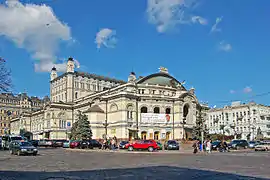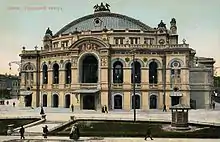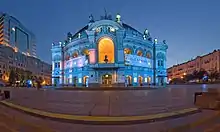National Opera of Ukraine
The Kyiv Opera group was formally established in the summer of 1867, and is the third oldest in Ukraine, after Odesa Opera and Lviv Opera.
 Ukrainian National Opera House in Kyiv | |
| Address | vul. Volodymirska, 50 Kyiv Ukraine |
|---|---|
| Coordinates | 50°26′48″N 30°30′45″E |
| Designation | State Register of Immovable Landmarks of Ukraine |
| Capacity | 1683[1] |
| Construction | |
| Opened | 29 September 1901 |
| Architect | Victor Schröter |
| Website | |
| opera.com.ua | |
The Kyiv Opera Company perform at the National Opera House of Ukraine named after Taras Shevchenko in Kyiv. The opera in 2 acts, Natalka Poltavka, was the last scheduled performance before the 2022 Russian invasion of Ukraine.[2]
History
Early history: 1867 – 20th century
.jpg.webp)



Established in the summer of 1867 by Ferdinand Berger (? – 1875). Berger succeeded in inviting many talented singers, musicians, and conductors, and the city council (duma) had offered the newly created troupe to use the City Theatre (constructed in 1856, architect I. Shtrom) for their performances. Officially, the theatre was named the City Theatre but was most commonly referred to as the Russian Opera. The day of the first performance, November 8 (October 27 old style), 1867 was made a city holiday. The performance of the opera Askold's Tomb by Alexey Verstovsky was the troupe's debut. The cast included contralto Nataliya Oleksandrivna Mykhaylovska.[3] The initial success is attributed to the vocal talents of that time of O. Satagano-Gorchakova, F. L'vov, M. Agramov but also the captivating plot taken from some principal pages of the ancient history of the city.
Early performances were mostly Russian operas, including Ruslan and Ludmila by Mikhail Glinka, Rusalka by Alexander Dargomyzhsky, Maccabees by Anton Rubinstein and The Power of the Fiend by A. Serov, as well as translated European operas including The Barber of Seville by Rossini, The Marriage of Figaro by Mozart, Der Freischütz by Weber, Lucia di Lammermoor by Donizetti, and operas by Giuseppe Verdi, which became the favorite of the Kyivites.
On February 4, 1896, after a morning performance of Eugene Onegin by Tchaikovsky, a fire erupted from an unextinguished candle in the theatre. The fire consumed the whole building within several hours. One of the largest musical libraries in Europe along with numerous costumes and stage props of many performances were lost during the fire. After the fire of the City Theatre, the troupe performed on other stages for several years, including Bergonie's Theatre (now the National Theatre of Russian Drama named after Lesya Ukrainka), Solovtsov's Theatre (now the National Theatre named after Ivan Franko) and even on the arena of the famous Krutikov's Circus.
Early 20th century
After the fire, the City Council had announced the international competition to design a new building for the Opera Theatre in Kyiv. The winning proposal was by Victor Schröter. The exterior was designed in Neo-Renaissance style and had accounted for the needs of the actors and the spectators. The interior was redesigned in a classical style and called Viennese Modern. However, his greatest achievement is considered to be the stage – one of the largest in Europe designed to the latest engineering standards.
On September 29 [O.S. September 16] 1901, the solemn opening of the new premise of the theatre took place with a performance of cantata Kyiv by composer Wilhelm Hartweld (1859–1927) and a presentation of the opera Life for the Tsar by M. Glinka.

On 14 September [O.S. 1 September] 1911, there was a performance of Rimsky-Korsakov's The Tale of Tsar Saltan at the Kyiv Opera House in the presence of the Tsar and his two oldest daughters, the Grand Duchesses Olga and Tatiana. The theater was occupied by 90 men posted as interior guards.[4] During the intermission of a performance Prime Minister Pyotr Stolypin was killed. According to Alexander Spiridovich, after the second act "Stolypin was standing in front of the ramp separating the parterre from the orchestra, his back to the stage. On his right were Baron Freedericks and Gen. Suhkomlinov." His personal bodyguard had gone to smoke. Stolypin was shot twice, once in the arm and once in the chest by Dmitry Bogrov, a leftist revolutionary, trying to rehabilitate himself. Bogrov ran to one of the entries and was subsequently caught. "He [Stolypin] turned toward the Imperial Box, then seeing the Tsar who had entered the box, he made a gesture with both hands to tell the Tsar to go back." The orchestra began to play "God Save the Tsar." The doctors hoped Stolypin would recover, but despite never losing consciousness, his condition deteriorated. The next day, the distressed Tsar knelt at Stolypin's hospital bedside and kept repeating the words "Forgive me". Stolypin died three days later.
In the first decade of the 20th century, the Kyiv Opera Theatre attracted the most outstanding Ukrainian and Russian singers, including O. Petlyash, P. Tsecevich, K. Voronets, M. Medvedev, K. Brun, O. Mosin and O. Kamionsky and famous opera stars from the West often came on tours. Several unusual for the time performances took place on the stage: Die Walkure by Wagner, Sadko by Rimsky-Korsakov and Mefistofele by Arrigo Boito.
Ukrainian state
In 1917, the opera house was used not only for art but also for congresses. In particular, in 1917 the Second All-Ukrainian Military Congress was held in the Opera House well known for the First Universal of the Ukrainian Central Council proclamation.
At the time Ukrainian State, the Kyiv Opera was called the Ukrainian Drama and Opera Theater . Operas were staged in Ukrainian translation, particularly in 1918 were staged: "Faust", "La Traviata", "Bohemia", "Madame Butterfly" and others. It was written in Ukrainian press that Ukrainian State Opera has every reason and potential to become one of the best theaters of its time, while warning that "Ukrainian State Opera should not repeat the history of Petrograd state theaters, which gave foreign culture and citizenship culture…" and stressing that it is necessary to "organize the work of the opera artistically strong, national and cultural".[5]
Soviet time
After Ukraine was annexed by Soviet Union the theater was nationalized and named the K. Liebknecht State Opera House. In 1926 it was renamed the Kyiv State Academic Ukrainian Opera, and in 1934, when Kyiv was returned the capital status, the Academic Opera and Ballet Theater of the USSR. In 1936 the theater was awarded Order of Lenin, and in 1939 was named after Taras Shevchenko.[6]
According to the Decree of the People's Commissar of 1926 all the operas were performed in Ukrainian language. This inspired the establishment of the full value of Ukrainian culture and language.[7] The tradition of performing opera in Ukrainian translations succeeded until the early 1990s.[8]
In 1981 the world premiere of a ballet based on the life of Olga of Kiev was performed to commemorate the 1500th anniversary of the city.[9]
1990–2010s
In 1991–1999, the National Opera was headed by Anatoliy Mokrenko. At this time, the theater is gradually beginning to abandon Ukrainian-language translations, which was explained by economic difficulties and the need for touring activities for artists survival.
See also
References
- "Ukrainian National Opera and Ballet Theatre of T.H.Shevchenko". Facebook. Retrieved 25 April 2011.
- "Upcoming shows | Національна опера України".
- Лисенко І. М. (English: Lysenko, І. М.) (1997). "Михайловська Наталія Олександрівна (English: Nataliya Oleksandrivna Mykhaylovska)". Словник співаків України (English: Dictionary of Singers of the Ukraine) (PDF) (in Ukrainian). Рада (English: Rada). p. 203.
- "Murder of Prime Minister Stolypin in Kiev 1911 – Blog & Alexander Palace Time Machine". www.alexanderpalace.org.
- Hay-Nyzhnyk, Pavlo (2003). "Formation of Ukrainian theatrical art and the issue of its taxation under the Hetmanate of 1918 [Становлення українського театрального мистецтва і питання його оподаткування за Гетьманату 1918 року]". Ukrainian Theatre (in Ukrainian) (5–6): 10–12. Archived from the original on November 11, 2012. Retrieved December 25, 2008.
- "National Academic Opera and Ballet Theater of Ukraine named after T. Shevchenko" (in Ukrainian). encyclopedia of the modern Ukraine.
- Maksym Strikha (February 2012). "Opera: confusion instead of content". tyzhden.ua (in Ukrainian). Archived from the original on August 29, 2021. Retrieved December 27, 2019.
- Andriy Bondarenko (2019). "Ukrainian Vocal Translations: Tradition and Perspectives". Bulletin of Kyiv National University of Culture and Arts. Series in Musical Art (2): 151–162.
- Черкашина-Губаренко М. Р. Театральні університети Володимира Рожка. Часопис Національної музичної академії України імені П. І. Чайковського. 2016. № 3 (32). с. 52.
External links
![]() Media related to National Opera of Ukraine at Wikimedia Commons
Media related to National Opera of Ukraine at Wikimedia Commons